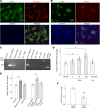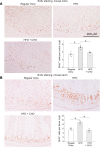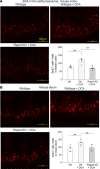Secondary bile acids mediate high-fat diet-induced upregulation of R-spondin 3 and intestinal epithelial proliferation
- PMID: 36099053
- PMCID: PMC9675439
- DOI: 10.1172/jci.insight.148309
Secondary bile acids mediate high-fat diet-induced upregulation of R-spondin 3 and intestinal epithelial proliferation
Retraction in
-
Secondary bile acids mediate high-fat diet-induced upregulation of R-spondin 3 and intestinal epithelial proliferation.JCI Insight. 2024 Jun 10;9(11):e181492. doi: 10.1172/jci.insight.181492. JCI Insight. 2024. PMID: 38855870 Free PMC article. No abstract available.
Abstract
A high-fat diet (HFD) contributes to the increased incidence of colorectal cancer, but the mechanisms are unclear. We found that R-spondin 3 (Rspo3), a ligand for leucine-rich, repeat-containing GPCR 4 and 5 (LGR4 and LGR5), was the main subtype of R-spondins and was produced by myofibroblasts beneath the crypts in the intestine. HFD upregulated colonic Rspo3, LGR4, LGR5, and β-catenin gene expression in specific pathogen-free rodents, but not in germ-free mice, and the upregulations were prevented by the bile acid (BA) binder cholestyramine or antibiotic treatment, indicating mediation by both BA and gut microbiota. Cholestyramine or antibiotic treatments prevented HFD-induced enrichment of members of the Lachnospiraceae and Rumincoccaceae, which can transform primary BA into secondary BA. Oral administration of deoxycholic acid (DCA), or inoculation of a combination of the BA deconjugator Lactobacillus plantarum and 7α-dehydroxylase-containing Clostridium scindens with an HFD to germ-free mice increased serum DCA and colonic Rspo3 mRNA levels, indicating that formation of secondary BA by gut microbiota is responsible for HFD-induced upregulation of Rspo3. In primary myofibroblasts, DCA increased Rspo3 mRNA via TGR5. Finally, we showed that cholestyramine or conditional deletion of Rspo3 prevented HFD- or DCA-induced intestinal proliferation. We conclude that secondary BA is responsible for HFD-induced upregulation of Rspo3, which, in turn, mediates HFD-induced intestinal epithelial proliferation.
Keywords: Colorectal cancer; Gastroenterology; Mouse stem cells.
Conflict of interest statement
Figures








Similar articles
-
An elevated deoxycholic acid level induced by high-fat feeding damages intestinal stem cells by reducing the ileal IL-22.Biochem Biophys Res Commun. 2021 Nov 19;579:153-160. doi: 10.1016/j.bbrc.2021.09.061. Epub 2021 Sep 25. Biochem Biophys Res Commun. 2021. PMID: 34601200
-
Intestinal Stem Cells Damaged by Deoxycholic Acid via AHR Pathway Contributes to Mucosal Barrier Dysfunction in High-Fat Feeding Mice.Int J Mol Sci. 2022 Dec 8;23(24):15578. doi: 10.3390/ijms232415578. Int J Mol Sci. 2022. PMID: 36555220 Free PMC article.
-
Effects of Bile Acid Modulation by Dietary Fat, Cholecystectomy, and Bile Acid Sequestrant on Energy, Glucose, and Lipid Metabolism and Gut Microbiota in Mice.Int J Mol Sci. 2022 May 25;23(11):5935. doi: 10.3390/ijms23115935. Int J Mol Sci. 2022. PMID: 35682613 Free PMC article.
-
ABL1‒YAP1 axis in intestinal stem cell activated by deoxycholic acid contributes to hepatic steatosis.J Transl Med. 2024 Dec 20;22(1):1119. doi: 10.1186/s12967-024-05865-6. J Transl Med. 2024. PMID: 39707364 Free PMC article.
-
Bile acid binding resin prevents fat accumulation through intestinal microbiota in high-fat diet-induced obesity in mice.Metabolism. 2017 Jun;71:1-6. doi: 10.1016/j.metabol.2017.02.011. Epub 2017 Feb 27. Metabolism. 2017. PMID: 28521862
Cited by
-
Are gut dysbiosis, barrier disruption, and endotoxemia related to adipose tissue dysfunction in metabolic disorders? Overview of the mechanisms involved.Intern Emerg Med. 2023 Aug;18(5):1287-1302. doi: 10.1007/s11739-023-03262-3. Epub 2023 Apr 4. Intern Emerg Med. 2023. PMID: 37014495 Free PMC article. Review.
-
Bile Acids, Intestinal Barrier Dysfunction, and Related Diseases.Cells. 2023 Jul 19;12(14):1888. doi: 10.3390/cells12141888. Cells. 2023. PMID: 37508557 Free PMC article. Review.
-
Association between Gut Microbiota and Digestive System Cancers: A Bidirectional Two-Sample Mendelian Randomization Study.Nutrients. 2023 Jun 28;15(13):2937. doi: 10.3390/nu15132937. Nutrients. 2023. PMID: 37447263 Free PMC article.
-
The gut microbiota in obesity and weight management: microbes as friends or foe?Nat Rev Endocrinol. 2023 May;19(5):258-271. doi: 10.1038/s41574-022-00794-0. Epub 2023 Jan 17. Nat Rev Endocrinol. 2023. PMID: 36650295 Review.
-
Microbial metabolites in colorectal tumorigenesis and cancer therapy.Gut Microbes. 2023 Jan-Dec;15(1):2203968. doi: 10.1080/19490976.2023.2203968. Gut Microbes. 2023. PMID: 37095682 Free PMC article. Review.
References
Publication types
MeSH terms
Substances
Grants and funding
LinkOut - more resources
Full Text Sources
Molecular Biology Databases

